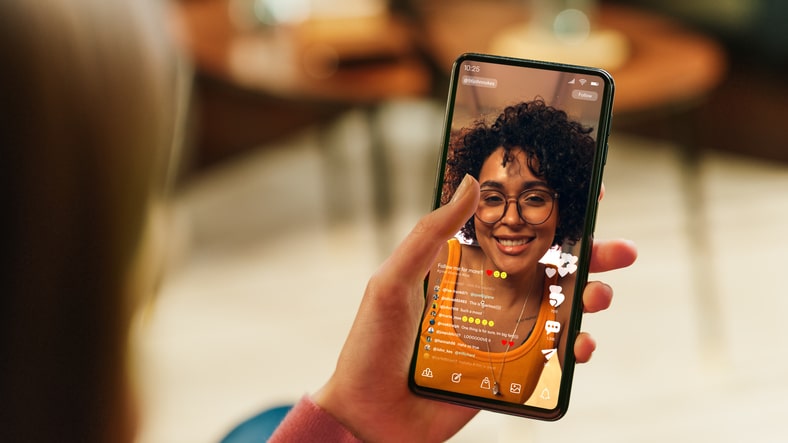
Video content is a fantastic way to engage audiences, informing and capturing your brand’s message to your target audience in ways which still imagery simply cannot.
Videos are also a great storytelling device. Strong visuals or animation, supported with powerful audio, captivates audiences and can generate genuine feelings of sentiment among consumers towards your brand or business. It is through video content that huge brands like John Lewis, Coca Cola, Ben & Jerry’s, McDonald’s and so on tell their story and capture the emotions of adults and young people alike.
Before posting video on your brands socials, its of vital importance to consider what kind of content works best for each channel. For example, the type of video that suits an Instagram audience may not work for a LinkedIn audience. Its of vital importance to recognise the need for different video content across the different platforms, to ensure maximum engagement.
With that said, this blog will detail what video content works for some channels and what kind of video doesn’t work for other social media sites. This will support your brand’s content strategy for creating and optimising social posting moving forwards.

As a social media platform focused completely on ‘visual’ social posts, it will come as no surprise that Instagram has long been pushing users to create original content. As the channel continues to grow, the number of videos created each day by Instagram users has quadrupled since 2017.
With that said, for brands using multiple social channels, Instagram should be considered the primary tool for optimising videos. Instagram is a largely B2C platform, with fun and engaging video content at the heart of most users day-to-day interactions on the channel. If your brand has a either a fun or emotive story to tell its consumers, consider Instagram your chance to do this and to do it well.

With the volume of content out there on Instagram, its vital to make sure your videos are well-shot and well-produced to stand out against a sea of other content. Users won’t be impressed by videos that aren’t high quality, and that doesn’t feature good audio or strong visuals.
Since 2022, all video uploaded to the channel is now a reel. Instagram Reels are viewed in a vertical orientation (an aspect ratio 9:16). Any content you capture, if you intend it to be posted on Instagram, must consider this specific size and format or risk damaging the quality of the video when desperately trying to resize the original footage. Reel content also allows users to add ‘audio’, short sound snippets often created and posted by other Instagram users. Businesses must be wary here, avoid copyright by shunning audio that would require payment to use (such as a well-known chart song). Instead, focus on using ‘trending’ audio. A simple google search will reveal trending audio that you and your brand could potentially use in its video.

Meta is constantly updating the Instagram platform. Currently, reel content can be no longer than 90 seconds and stories are limited to 15 seconds. With that said, and considering the audience, your business will likely be targeting with Instagram, video posts should be ‘short and sweet’. To ensure you keep your audience’s attention, keep your videos striking and to the point, with a clear call to action if needed either in the video or the supportive social copy (“click the link in our bio to find out more”). Instagram videos should not get drawn into overexplaining your brand or product, instead try ‘wowing’ your audience with striking visuals and animation, audio that captures the mood of the video, and ideally keep it between 30-60 seconds. When optimising the content on Instagram Stories or Highlights, ensure it acts as a ‘teaser’ to the larger video or wider campaign your brand is pushing. Story content should in someway link to the feed post.

Last but not least, your Instagram content strategy should ensure hashtags are included in the social copy. Instagram’s algorithm ensures posts that feature hashtags are shown to the relevant audience. For example, car cleaning enthusiasts will see posts on their organic feed featuring hashtags such as #carcare and #carcleaning. If you want your video to be shown to the correct audience, include hashtags that are aligned with your audience’s interests. Instagram content will also rank higher when trending hashtags are used, as it ensures a greater chance of shareability and increases user engagement.
For more engagement, ensure your Instagram video follows the above advice.

Facebook is one of the top players in showcasing videos and increasingly users are using Facebook as its go-to for watching videos. As the most used social media platform to date, your brand must consider both organic and paid video content to maximise its message and increase brand awareness.
‘Native posting’ is the first thing to consider with Facebook. In the past, Facebook was used as an in-between site to direct users to another webpage if they wanted to watch a video. For example, a link to YouTube might feature in the social copy and not an embedded video. Brands should respect Facebook’s video marketing presence, create content for Facebook and ensure posts don’t direct users to other platforms. In doing so, your ‘native’ content will rank higher on users feeds thanks to the algorithm.

When considering how you can further ‘optimise’ your Facebook video, think how users may be viewing your content.
An interesting stat to consider is that over 80% of Facebook users watch video without sound. What’s important here is not why users are watching without sound, but how brands can get around this.
The solution is captions. Facebook allows users to automatically generate captions, ensuring audiences can read what’s going on despite not listening to the audio. If your business has the creative budget, consider creating the captions while finalising the content to ensure the text completely matches what people are saying in the video. This will bring clarity to users scrolling through their feeds and stopping on your video, driving both awareness and engagement.

Facebook is less restrictive on video than Instagram. Nonetheless, you should still consider avoiding making videos overly long and dragging.
For viral content, Facebook recommends videos that are less than one minute or stories that are less than 20 seconds in length. Short, snappy content that you want to drive awareness of your brand or offering shouldn’t be over a minute, as it will become dull and salesy to the user.
If your video serves a different purpose than driving awareness, then longer videos can be considered. If you’re targetting users and promoting a particular event for example, then ‘live stream’ content might be a different approach. Live streams can be as long as 8+ hours and if you’re announcing something exciting (i.e. a new product drop or awards night) – then videos will likely be longer than 60 seconds and this is ok.
It won’t come as a surprise that Facebook ranks ‘live streamed’ content higher on its site – to ensure maximum engagement for your post that moment it goes live. Your followers may also receive a notification to watch live, depending on their privacy settings. A great Facebook marketing strategy should consider both trending videos for driving awareness and live streams for engaging existing users.

LinkedIn is the largest B2B professional social media platform and video posts prove a great way to reach new businesses and relevant stakeholders.
As the content is B2B, rather than B2C in nature, the video should be informative as well as engaging. Although all videos (where appropriate) should prove visually striking, LinkedIn is not Instagram and instead your video content can prove more educational.
The best LinkedIn videos are informative and valuable to the user, who is on the platform looking for professional content as opposed to quirky reels or livestreams. When considering who your audience is on LinkedIn, you can ensure your video is the perfect balance of appropriate, enlightening and engaging.

As well as the educational video you’re pushing out, the headline and supportive copy prove just, if not more important than the visual content itself.
Make sure your headline and copy is enticing, avoiding the use of jargon and keeping it focused directly at the LinkedIn user/users you are trying to target. This will ensure that when users scroll down their LinkedIn feed, they will be enticed to click the video and find out more.
Although LinkedIn videos can be as long as 10 minutes, the best-performing content is no more than 90 seconds. Users across social channels are unlikely to watch overly long videos and even less likely to share the video with their LinkedIn followers. Short-form videos work across all accounts.

As part of a paid social media strategy, consider videos as a great way to ensure higher results. Video views campaigns often perform incredibly well with low-cost result, but generally speaking, video is a great way to elevate results across LinkedIn ads campaigns when static imagery is not performing well. Videos on LinkedIn prove more clickable and sharable for audiences and stats reveal LinkedIn native videos are even five times more likely than other content to start a conversation among LinkedIn members.
Research reveals that most users will watch a video on Twitter if it’s 30 seconds or less. Although Twitter allows for 140 seconds of video content, keep it shorter for maximum engagement.

Similarly to LinkedIn, Twitter videos are aimed at a more ‘mature’, ‘professional audience. Twitter is a fantastic source of information that matters, with live breaking news via trending hashtags and a “while you were out” section feeding you news, updates and product info from accounts you often engage with, as well as brands you and your Twitter ‘community’ follow.
Twitter favours native posting, and Twitter rewards this with higher ranking and greater engagement. With this in mind, do not direct users to another site for the video you are promoting. Since the controversial takeover of Twitter, new owner Elon Musk has himself tweeted that he wants Twitter to champion native content instead of being a middleman for directing traffic elsewhere. It would make sense here then, to take that advice.

The use of hashtags is core to optimising Twitter content.
Twitter videos should always feature trending, relevant hashtags. Hashtags are important in getting your video content on the feeds of the target audience. With the Twitter algorithm in mind, hashtags organise user tweets in such a way that it puts your tweet at the front line of search results related to that hashtag, ensuring the video reaches more people.
Hashtags help your brand gain maximum awareness, as well as driving engagement. Ensuring your Twitter video is supported by appropriate copy and hashtags will result in more likes, shares and traffic directed to your company site.

As discussed, Twitter videos need to be short and sweet. With this in mind, the first 3-5 seconds of the video is perhaps the most crucial in capturing audience attention.
You want your viewers to know what they’re watching and your brand instantly. This is particularly true if any of your video content is going to auto-play. If its a new product, try as best as possible to showcase the product, brand and its overall use in the first section of the short video. If necessary, leave users wanting more and support your video with a clear call to action to click the link to the website.
Twitter videos need to be optimised to entice audiences quicker than most other social channels, so keep this in mind when creating your Twitter social media marketing strategy.
At Prohibition, we work with a range of brands across all sectors, B2B & B2C, to create compelling videos that help to achieve a business goals and objectives. Get in touch today to find out how we could help you.
For more interesting articles from us check out these posts:
- Why You Should Utilise Video Content as Part of Your PR Strategy
- How brands can utilise TikTok to support PR strategies
- Step by step guide to create a corporate video for your marketing needs




